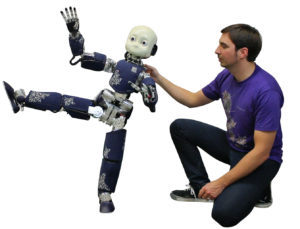AI and Learning in Robotics

The challenges in understanding human motor control, in brain-machine interfaces and anthropomorphic robotics are currently converging. Modern anthropomorphic robots with their compliant actuators and various types of sensors (e.g., depth and vision cameras, tactile fingertips, full-body skin, proprioception) have reached the perceptuomotor complexity faced in human motor control and learning. While outstanding robotic and prosthetic devices exist, current brain machine interfaces (BMIs) and robot learning methods have not yet reached the required autonomy and performance needed to enter daily life.
The groups vision is that four major challenges have to be addressed to develop truly autonomous learning systems. These are, (1) the decomposability of complex motor skills into basic primitives organized in complex architectures, (2) the ability to learn from partial observable noisy observations of inhomogeneous high-dimensional sensor data, (3) the learning of abstract features, generalizable models and transferable policies from human demonstrations, sparse rewards and through active learning, and (4), accurate predictions of self-motions, object dynamics and of humans movements for assisting and cooperating autonomous systems.